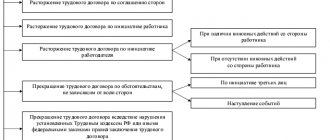Dismissal procedure
In order to leave the place of work of his own free will, an employee of the company must comply with all the prescribed steps. First, you need to competently and clearly compose the text of your resignation letter and hand it to the employer.
Next, the employee begins working for a mandatory period, which cannot exceed two weeks. Otherwise, the employee's rights will be violated. After the end of the maximum period, the employer issues a formal order to dismiss the employee.
The final stage is the employee receiving all due payments for the period worked and a work book. If the employer evades payment of funds, the employee has every right to seek justice with the help of law enforcement agencies. It is also important to check the presence of mandatory entries and marks in the work book.
Step-by-step instructions for actions upon dismissal
The reasons why a person decides to leave work can be completely different. But if this is not a violation of labor discipline or other violations due to which employees can be dismissed without their consent, then dismissal occurs according to the following scheme:
- An employee must write a letter of resignation 2 weeks before the expected termination of work (if there are no objective reasons regulated by the Labor Code of the Russian Federation that will allow one to stop working earlier).
- The application should be endorsed by management or registered as incoming correspondence with the secretary.
- The time worked before leaving begins to be counted from the date following the date of filing the application, and if the employee has no reason to leave without working, then he must comply with all instructions and perform work duties in full.
- Regardless of the reason for dismissal, the employee must read the dismissal order and sign it.
- On the day of dismissal, the organization must return the employee’s work book with a notice of dismissal and issue a paycheck.
The dismissal procedure must be strictly followed by the parties, so that if controversial issues arise, compliance with the Labor Code of the Russian Federation can be proven.
Application for resignation
This type of paper is drawn up by the applicant himself in free form. You can submit an application in any form. This means that the text can be provided on white A4 paper in printed or written form. However, it is worth remembering the necessary information that must be present.
Despite the lack of a uniform form of writing, it is worth following a certain template to avoid mistakes. So, the structure of the statement could be as follows:
- Full name of the person to whom this paper will be sent;
- Full name of the hired worker (author of the application);
- Explanation of the reasons for leaving work: at your own request;
- Date of termination of the employment contract (last day of work);
- The date the petition was written and the signature of the originator.
You can also find a form to fill out online, then print it out and fill in your personal information.
Registration of dismissal by agreement of the parties
Clause 1 of Article 77 of the Labor Code of the Russian Federation allows for the completion of work. relations by mutual agreement between the parties. The contract is terminated at any time if the parties reach agreement. Such dismissal is usually formalized in a separate document, which is called a “termination agreement.” agreement." The Ministry of Labor clarifies that this agreement can be signed at any time before the day of termination of work. relationships. That is, there is no need to work for 2 weeks, as required by the rules when leaving work of your own free will. It is enough to put the date in the document - the last working day and state that the basis for termination is labor. a contract is an agreement between the parties. The agreement may also contain additional conditions: the amount of compensation to the employee upon dismissal, if provided; the possibility of taking leave before dismissal; the employee’s obligation to transfer work to his replacement and train him; and so on. The document is drawn up in two copies, one of which is taken by the employee. The second copy, signed by the parties, remains with the employer. It is worth mentioning the judicial practice regarding issues of dismissal by agreement. There are court decisions according to which, for dismissal under paragraph 1 of Article 77 of the Labor Code of the Russian Federation, mutual consent of the parties is sufficient, not necessarily supported by a written additional document. That is, the form of the agreement itself is not important. According to a number of judges, dismissal under paragraph 1 of Article 77 of the Labor Code of the Russian Federation will be lawful, even if the employee simply writes a letter of resignation by agreement of the parties, and the employer issues a corresponding dismissal order. An important feature of dismissal by agreement is that such an agreement cannot be canceled unilaterally. If the employee or employer changes their mind about their decision, then neither of them will be able to revoke the agreement. It can only be annulled by reaching mutual agreement. When trying to restore labor. relationship, one of the parties may send the other an application to cancel the termination agreement. The second party either agrees to the cancellation or gives a written reasoned refusal. Dismissal by agreement occurs on the basis of a standard order, which states that the employment relationship has been terminated on the basis of paragraph 1 of Article 77 of the Labor Code of the Russian Federation. The employee gets acquainted with the order against signature. If you refuse to sign an order, a note indicating such refusal is made on it. After making an entry about the end of work in the organization, the work book is issued to the employee also against signature (you need to sign on the personal card). The work book is stamped and signed. In case of such dismissal, wages are paid for the days of the month worked, material compensation for non-use of vacation and other amounts due, if they are provided for by labor or call. agreement.
What should be indicated in the order
Only after receiving an official order can an employee of the organization be considered dismissed. For this reason, the employee must ensure that this document is drawn up correctly. The T-8 form is used as a sample.
Companies have the right to make their own changes to the type of order. However, there is mandatory information that cannot be excluded from the text:
- Full name of the organization;
- Company code according to OKPO;
- The number of the paper and the date of its preparation, as well as similar information about the employment contract being terminated;
- Date of termination of the employment relationship;
- The employee’s personnel number, full name, position and structural unit;
- Grounds for termination of an employment contract between the parties;
- Employee statement;
- Signatures of both parties.
If any clause is missing, the order will be invalid.
Calculation upon termination of an employment contract
The manager is obliged to pay in full all funds due to the person resigning on the last working day (salary according to the time worked, as well as other due payments, which may include compensation for unused vacation, etc.)
By the way, if the payment is not made due to the fault of the employee, then the obligation to pay is not canceled, but remains until an application for the payment of the due payments, which must be credited no later than the day following the application.
Also, the accounting department, when paying a person, is obliged to issue a certificate of income for the last 2 years or in case of any other request.
What entries are made in the work book?
Since receiving a paycheck and work book is the end of the voluntary dismissal process, it should be given special attention. If the book is issued without the corresponding records, the person will not have proof of experience and official place of work.
The employee must check for the following notes:
- The name of the company where the employee worked on the basis of an employment contract;
- Work start date;
- The position held by the worker;
- Reason for hiring and date of dismissal;
- Reason for termination of the employment contract and related relations;
- Seal of the organization;
- Signatures of the terminated employee and an authorized HR representative.
Base 1
According to the first paragraph of Article 77 of the Code, dismissal is carried out by agreement of the parties. In this case, the employment relationship is terminated at the initiative of the employee. In fact, there are often cases of termination of employment relationships at the request of the employee, but with certain features.
Agreements may relate to the issue of payment, training conditions for a new employee, and other things. For example, you can agree that the employee leaves for another place without working off. But in return, he undertakes to check the reports of the person who comes to replace him once a week.
Duration of the voluntary dismissal procedure
The dismissal process, like any other, takes some time. In this case, this period cannot exceed 14 days from the date of submission of the application.
If an employee leaves the probationary period, the period lasts only 3 days.
In certain cases, the parties can agree and reduce the working period by a couple of days. It is impossible to obtain such an agreement regarding the extension of the contract, since this is contrary to the law and entails liability.
The resignation letter is not signed
In some cases, when dismissing at his own request, the employer does not want to lose an employee valuable to the company. For this reason, the employer may try to delay the signing of the document. Nevertheless, in such situations, the employee can count on the protection of the state, since it always takes the side of the injured party.
The hiring party has no right to delay or delay the dismissal of an employee. Also, the signature of the organization’s management is not the main condition for terminating the employment relationship.
R
The employee has the right to leave two weeks after the day the application is submitted. If the employer does not want to make a calculation and return the work book, this is a serious violation of the laws of the Russian Federation. An employee can count on the protection of his rights in court.
Contract termination procedure
This procedure is established in Art. 80 Labor Code of the Russian Federation. Its main provision is the need to work for two weeks. This is necessary so that the employer has time to hire another employee.
The nuances of voluntary dismissal:
- when indicated in labor clause 3, part 1, art. 77 of the Labor Code of the Russian Federation, dismissal at will without service is possible, in Art. 80 states that the parties can agree on this separately;
- a written statement from the employee is the only documentary basis;
- if a citizen cannot continue to work for objective reasons (enrollment in a university, violations of the employer), the contract is terminated within the period determined by the employee;
- calculation (documentary, material) is made on the last day of work;
- before the expiration of two weeks, the employee has the right to withdraw his initiative. But the employer may insist on dismissal if another employee has already been invited and cannot be refused;
- if the application is submitted, but the employee continues to work and the employer does not object, the contract is not terminated.
In judicial practice, special attention is paid to documentary or other support of all circumstances. If in a legal dispute about reinstatement an employee refers to forced dismissal, he is obliged to prove it (oral evidence is also allowed). If an employee refers to violations of the employer, they must be supported by acts of state control authorities, etc.
Consent to work on a day off - how to draw up a document and how much will they pay in 2021?
Is it possible to withdraw an application?
If, during a two-week work period, an employee changes his decision regarding his upcoming dismissal, nothing prevents him from revoking the document. This is quite simple to do: you need to write a petition in which you must indicate a request to cancel the previous application.
However, the second application will not be satisfied if a new candidate has already been found for this job. The former employee will be automatically dismissed, and the new employee will begin to fulfill his obligations.
Is it possible to avoid processing
Quitting prematurely is certainly possible. An employee may not work for two weeks in the following cases:
- The hired worker fulfilled his obligations during the probationary period. In this case, the work period will be 3 days.
- Due to a conflict between the parties to the employment agreement, in which the employer is at fault, the employee may stop working on the day the application is submitted.
- The parties came to a mutual agreement regarding the reduction or cancellation of the working period.
- The employee intends to enroll in an educational institution and has a document that confirms this action.
- The employee is disabled or has disabled children.
- The worker is called up for military service.
- The employee's spouse must go on a long business trip to another city.
- The employee quits during official sick leave and has the appropriate certificate.
All of these cases provide the opportunity to reduce or completely cancel the working period.
Features of dismissal of pensioners
If a citizen reaches retirement age, he can go on a well-deserved rest and resign from his previous job at his own request. The procedure for severing employment relations is identical to the standard one.
Nevertheless, a difference still exists - if you indicate in the application that a person wants to resign due to retirement, no work is required. However, this rule only applies to the first dismissal. If the pensioner later gets another job, the procedure for terminating the employment contract will follow a general procedure.
According to Article 77, paragraph No. 3, part one, severance of labor relations at the initiative of the employee is possible only if all appropriate conditions are met. The state has determined the rights and obligations of each subject of these legal relations in order to eliminate the possibility of disagreement. In case of violation of the regulations, the guilty party will be punished accordingly.
Article 77. General grounds for termination of an employment contract.
§ 1. Termination of an employment contract is the end of the employment relationship between the employee and the employer. This differs from the removal of an employee from work, when the employee’s performance of his labor function is only suspended. In this case, as a rule, wages are not paid for the period of suspension (see Article 76 and commentary thereto). Termination of an employment contract means the dismissal of an employee. In accordance with the conceptual apparatus, the legislator uses three terms: “termination”; "termination"; "dismissal" The first two terms are used in relation to an employment contract. Moreover, the term “termination” is broader than “termination”. The concept of “termination of an employment contract” is applied in cases where the contract is terminated at the initiative of the employee, or the employer, or by agreement of the parties to the employment contract. The term “dismissal” is used in relation to a specific employee (for example, engineer M.I. Ivanov was fired at the initiative of the employer under clause 2, part 1, article 81 of the Labor Code of the Russian Federation). The commented article contains common grounds for termination of an employment contract for all employees.
§ 2. Clause 1 part 1 art. 77 of the Labor Code provides for such a basis as by agreement of the parties. It reflects the contractual nature of labor: by agreement of the parties, as a rule, an employment relationship arises, and by their agreement it is terminated at any time. On termination of an employment contract, see Art. 78 TC and commentary to it.
§ 3. According to clause 2, part 1, art. 77 of the Labor Code, the basis for termination of an employment contract is the expiration of the term of the employment contract (Article 79 of the Labor Code), except for cases where the employment relationship actually continues and neither party has demanded its termination. See Art. 79 and commentary thereto.
§ 4. According to clause 3, part 1, art. 77 of the Labor Code, an employment contract is terminated at the initiative of the employee (Article 80 of the Labor Code and commentary thereto).
§ 5. In accordance with clause 4, part 1, art. 77, there is termination of the employment contract at the initiative of the employer (see Articles 71 and 81 of the Labor Code and comments to them).
§ 6. Clause 5, Part 1, Art. 77 of the Labor Code, which establishes such grounds for termination of an employment contract as the transfer of an employee with his consent or at his request to another employer, is applied when there is a clearly expressed written will of three subjects: the administration of the new place of work, inviting to work, the given employee, the transferring from one place of work to another in the order of transfer, and the administration of the previous place of work releasing this employee in the order of transfer to another organization. Then the employment contract with him is terminated at his previous place of work under clause 5, part 1, art. 77. At the new place they can no longer refuse to hire him (see Article 64 of the Labor Code and the commentary thereto). Clause 5, Part 1, Art. 77 of the Labor Code contains another basis for termination of an employment contract - transfer to an elective job (position). For this basis, an act of election of this employee to an elective job (position) exempt from production work is required. The previous and this grounds for dismissal, as we see, differ significantly from each other. Therefore, in the dismissal order and in the employee’s work book there should be a reference not just to clause 5 of Art. 77 of the Labor Code, and with clarification on which of these two grounds the employee is dismissed.
§ 7. Clause 6, Part 1, Art. 77 of the Labor Code provides for such grounds as the employee’s refusal to continue working in connection with: a) a change in the owner of the organization’s property; b) with a change in the jurisdiction (subordination) of the organization; c) with the reorganization of the organization (Article 75 of the Labor Code). All three cases have now become quite common. For more details, see Art. 75 and commentary thereto.
§ 8. Clause 7, Part 1, Art. 77 of the Code establishes the general basis for dismissal, which was introduced in 1988 in paragraph 6 of Art. 33 of the Labor Code as supplemented. This is “refusal to continue work due to a change in the terms of the employment contract determined by the parties” (see commentary to Article 74 of the Labor Code). Now the Code has included this basis in a separate paragraph. Such a refusal by the employee may occur if he was offered another job in the same organization or if there was no corresponding work after he refused to continue working with a change in the essential terms of the employment contract. If there was another job, but the employee was not offered it, having learned about this, he can file a lawsuit to reinstate him in the unoffered job, and the court, having established such a violation of Art. 74 of the Code will satisfy his claims.
§ 9. Clause 8, Part 1, Art. 77 Labor Code - a new basis for dismissal. Previously, an employee who refused to be transferred to another job based on a medical report on his health condition was dismissed on the grounds of unsuitability for health reasons (clause 2 of Article 33 of the Labor Code). Selected paragraph 8 of Art. 77 grounds are more true and less likely to injure the employee, correctly reflecting the dismissal initiative.
§ 10. Enshrined in clause 9, part 1, art. 77 of the Labor Code the basis was previously contained in paragraph 6 of Art. 29 Labor Code. This is an employee’s refusal to be transferred to another location due to the employer (organization) moving there. In this case, the employee is paid severance pay in the amount of his two-week earnings (see Article 178 of the Labor Code and commentary thereto). When an employer moves to another area (i.e., to another locality), the administration invites not everyone to move, but, as a rule, the main employees, and if one of them does not agree to the move, he is fired according to clause 9 Art. 77 due to refusal to move with the organization to work in another area. If the employee was not offered a move, he is dismissed under clause 1 of Art. 81 of the Labor Code with appropriate guarantees in connection with the liquidation of this organization in this area (see commentary to Article 81 of the Labor Code).
§ 11. Clause 10, Part 1, Art. 77 refers to Art. 83 “Termination of an employment contract due to circumstances beyond the control of the parties.” It provides for specific circumstances. Therefore, on clause 10, part 1, art. 77 they never make references either in the order or in the work book, since it is a reference.
§ 12. Clause 11 of Part 1 of Art. is also of a referential nature. 77. The reasons for dismissal specified therein are discussed in detail in Art. 84 of the Labor Code on violation of the rules for concluding an employment contract established by labor legislation, if this violation excludes the possibility of continuing work. This new basis fills the gap in the Labor Code.
§ 13. Part 2 Art. 77 of the Labor Code provides that an employment contract may be terminated on other grounds provided for by the Code and other federal laws. For example, in Sect. XII of the Code specifies additional grounds for dismissal for teaching staff and organizational leaders. There are additional grounds for the dismissal of federal civil servants, judges, and prosecutors, provided for by the relevant federal laws. It should be noted that Art. 77 contains a non-exhaustive list.





